
Prosopis is a genus of flowering plants in the family Fabaceae. It contains around 45 species of spiny trees and shrubs found in subtropical and tropical regions of the Americas, Africa, Western Asia, and South Asia. They often thrive in arid soil and are resistant to drought, on occasion developing extremely deep root systems. Their wood is usually hard, dense and durable. Their fruits are pods and may contain large amounts of sugar. The generic name means "burdock" in late Latin and originated in the Greek language.

Glycyrrhiza is a genus of about 20 accepted species in the legume family (Fabaceae), with a subcosmopolitan distribution in Asia, Australia, Europe, and the Americas.
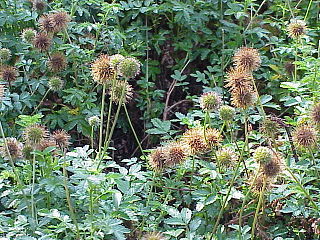
Acaena is a genus of about 60 species of mainly evergreen, creeping herbaceous perennial plants and subshrubs in the family Rosaceae, native mainly to the Southern Hemisphere, notably New Zealand, Australia and South America, but with a few species extending into the Northern Hemisphere, north to Hawaii and California.

Calandrinia is a large genus of flowering plants known as purslanes and redmaids. It includes over 100 species of annual and perennial herbs which bear colorful flowers in shades of red to purple and white. Plants of this genus are native to Australia, western South America, Central America, and western North America. Some species have been introduced to parts of New Zealand, southern Africa, Asia, and Europe.

Loasa is a genus of flowering plants in the family Loasaceae. The genus contains about 100 species native to Central and South America. Species of Loasa are prickly herbs or shrubs that have nettle-like stinging hairs. Some species of Loasa are grown as ornamental plants and are known as Chile nettle. Its flowers have five yellow petals covering united stamens and distinctive large coloured nectaries. Caiophora is a closely related genus that also has stinging hairs and is found on rocky slopes of the Andes.
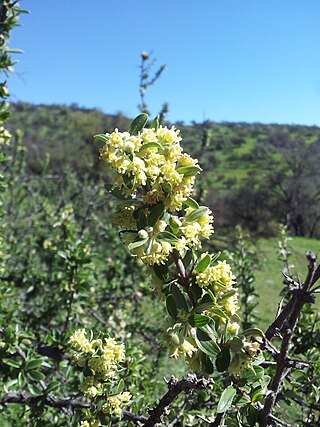
Trevoa is a genus of actinorhizal plants; these dicotyledon flora are trees or small shrubs. The genus was first proposed by Miers in 1825, but was not fully described until 1830 by Sir William Jackson Hooker. Genus members are notable for their ability to fix nitrogen. Species of this genus are generally found in the near coastal forests and arid shrubland of South America. Some species are localized in the mountains of central Chile; for example, the species Trevoa trinervis occurs in the La Campana National Park and other proximate areas of central Chile.
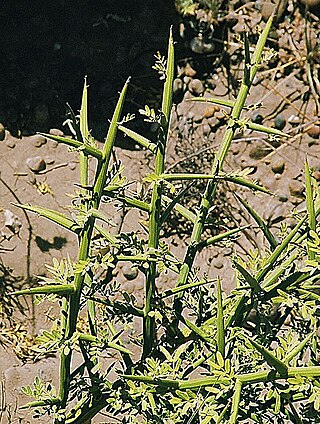
Prosopidastrum is a genus of flowering plants in the family Fabaceae. It includes seven species of shrubs native to the subtropical Americas, with six species native to Bolivia and Argentina, and one native to Baja California. They grow in subtropical xerophytic bushland, thicket, grassland, and semi-desert. It belongs to the mimosoid clade of the subfamily Caesalpinioideae.

Adesmia is a genus of flowering plants in the legume family, Fabaceae. It was recently assigned to the informal monophyletic Adesmia clade within the Dalbergieae.

Anarthrophyllum is a genus of flowering plants in the family Fabaceae. It belongs to the subfamily Faboideae.
John Gillies (1792–1834) was a Scottish naval surgeon who later became an explorer and botanist, travelling extensively in South America. Educated at the University of Edinburgh, he served in the Royal Navy during the Napoleonic Wars. Afflicted by tuberculosis, Gillies left the UK aged 28 for South America in the hope that the climate would improve his fragile health. He spent eight years there, mostly in Argentina, surviving wars, civil unrest, and chronic ill health, sending numerous plants to Hooker at the Royal Botanic Gardens Kew before returning in 1828. He died aged 42 at Edinburgh on 24 November 1834, his remains interred at Calton.

Leucheria is a genus of flowering plants in the family Asteraceae.
Dalea elegans is a species of flowering plants in the legume family, Fabaceae. It is found in Argentina and Bolivia.
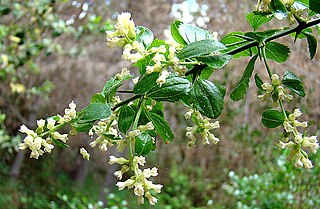
Retanilla is a genus of flowering plants in the family Rhamnaceae, native to Chile, Peru, and Argentina. The species in this genus are actinorhizal plants.
Tetraglochin is a genus of flowering plants belonging to the family Rosaceae.
Tarasa is a genus of flowering plants belonging to the family Malvaceae.
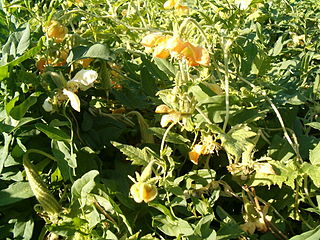
Caiophora is a genus of flowering plants belonging to the family Loasaceae.
Culcitium is a genus of flowering plants belonging to the family Asteraceae.
Montiopsis is a genus of flowering plants belonging to the family Montiaceae.
Neanotis is a genus of flowering plants belonging to the family Rubiaceae, and the major group Angiosperms.

Plectrocarpa is a genus of flowering plants belonging to the family Zygophyllaceae.













